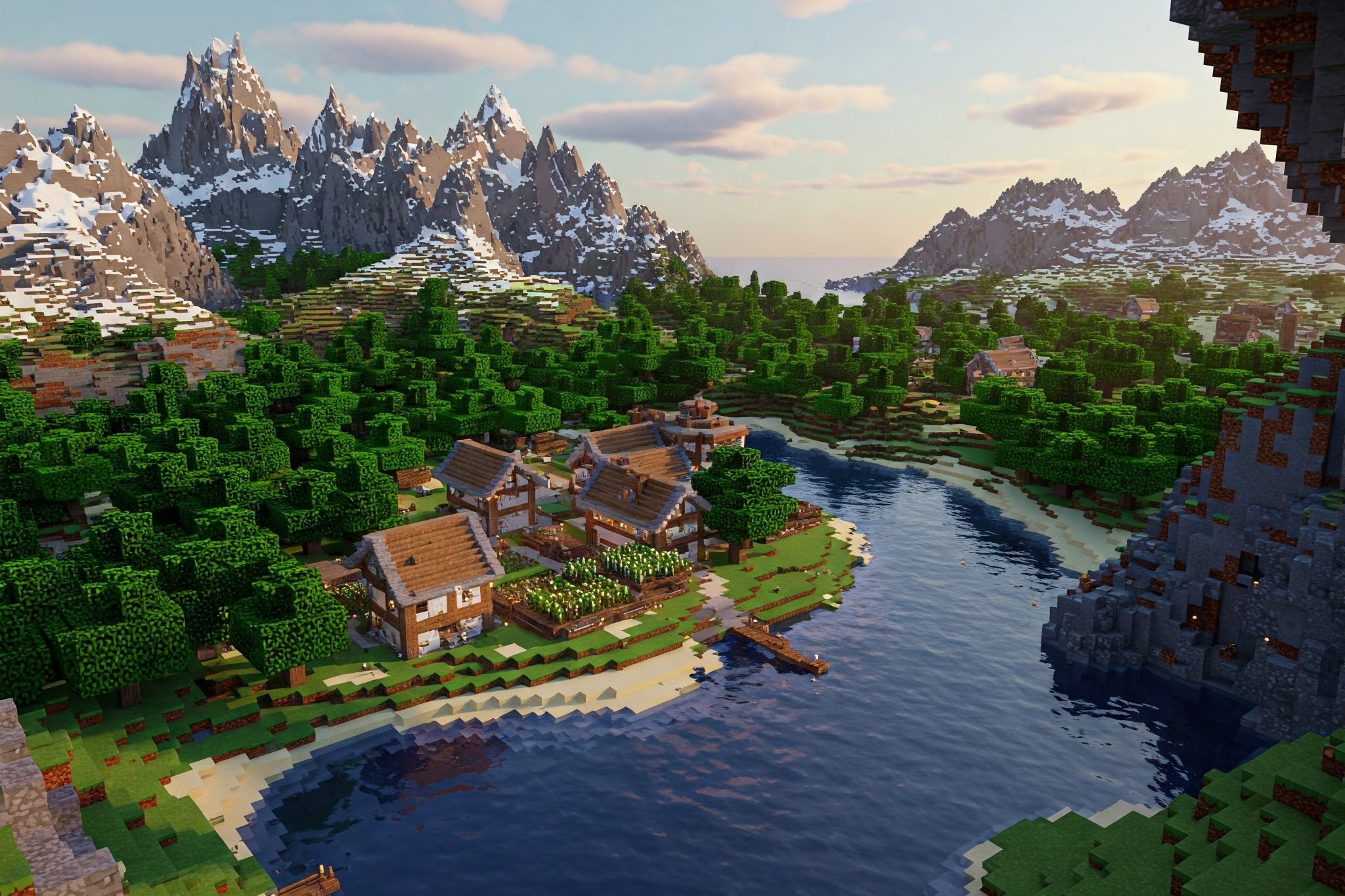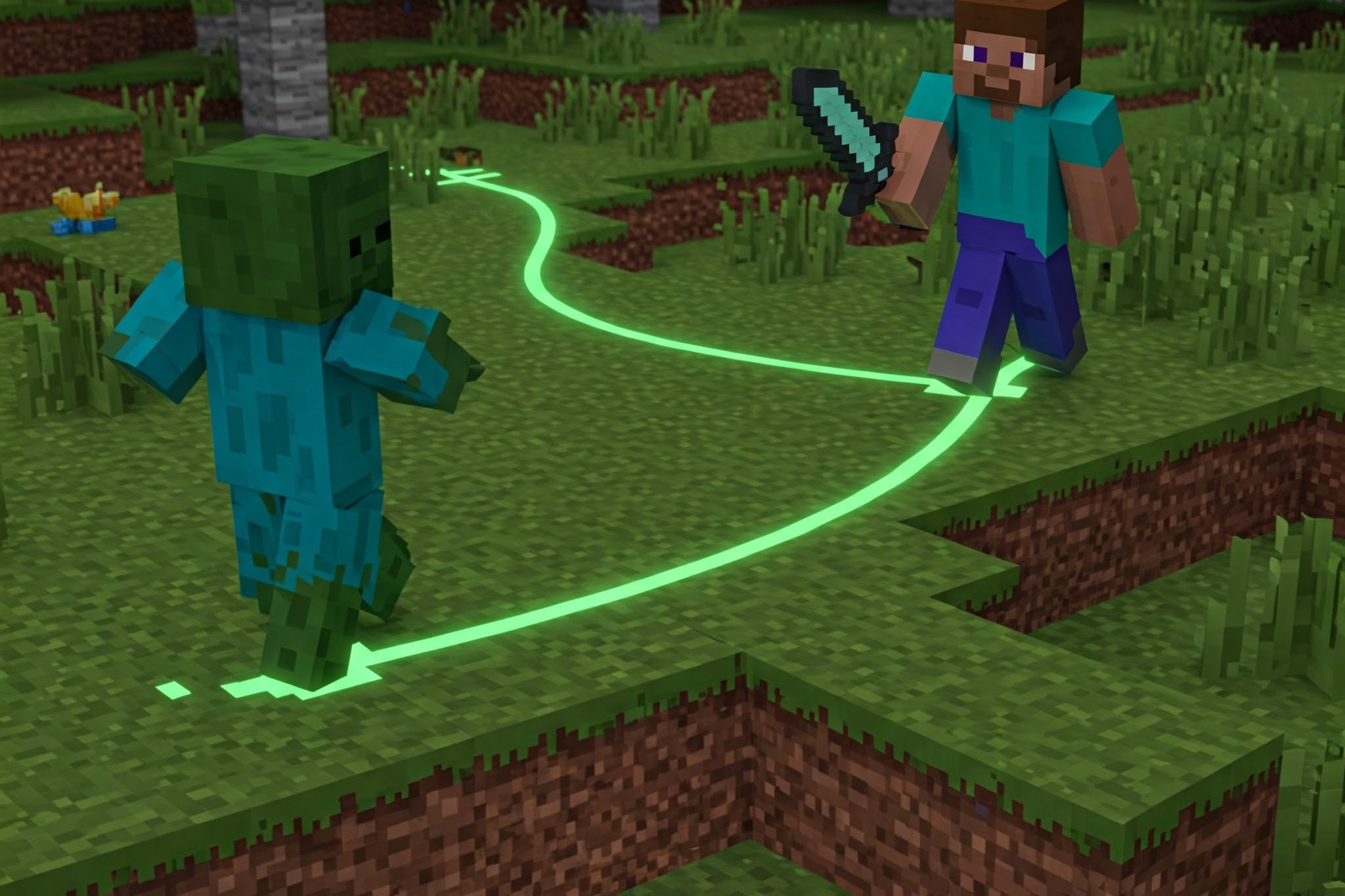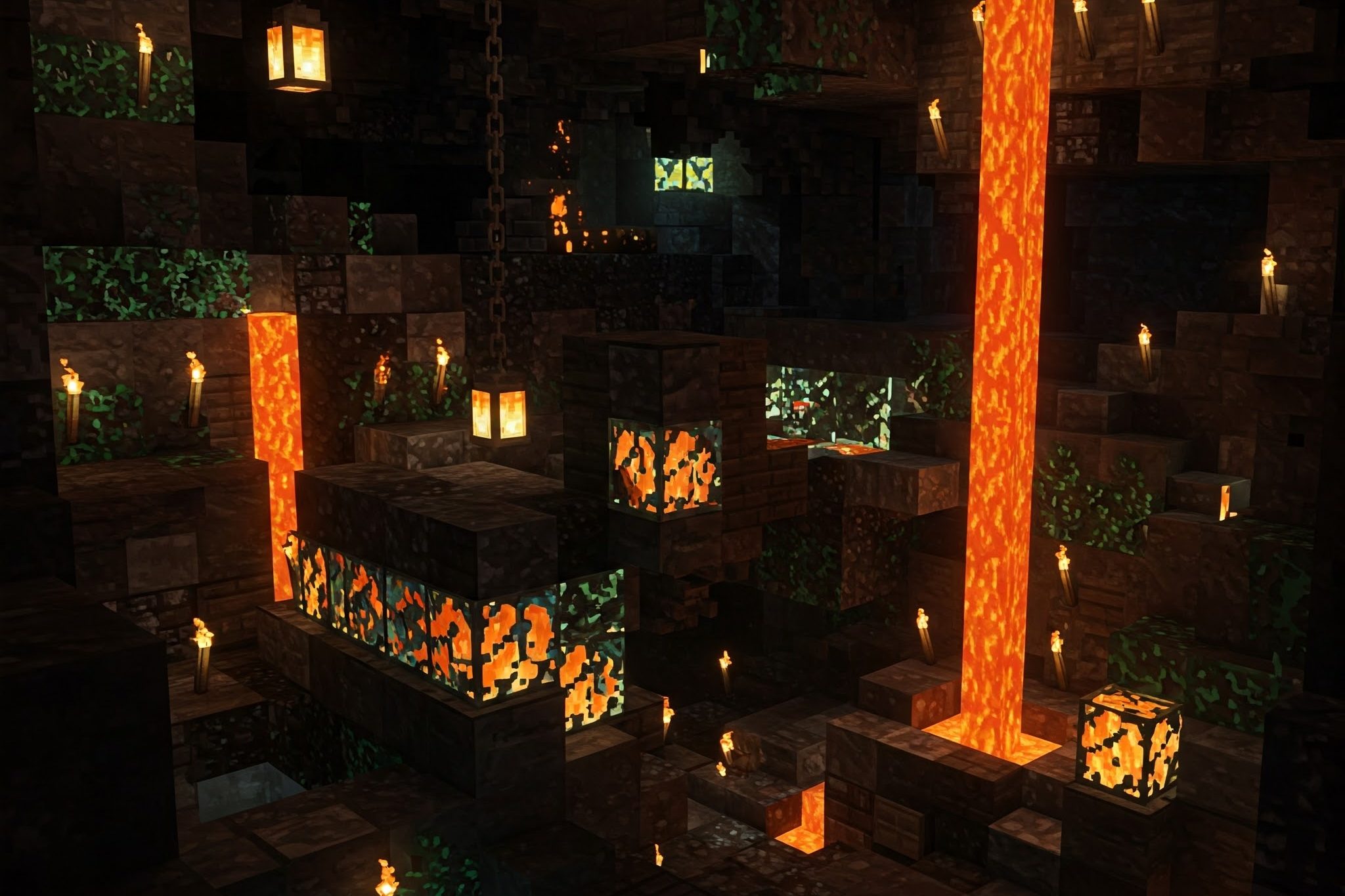The Minecraft Mechanics Lab: Glossary of Terms
Welcome to the Lab’s Glossary!
A
- AI (Artificial Intelligence):
- Definition: The set of rules and decision-making processes that govern the behavior of non-player entities (Mobs). This includes how they navigate the world (see Pathfinding), detect players or other mobs, decide whether to attack, flee, or perform other actions (like a Villager working at its station). Mob AI often involves state machines (e.g., idle, pursuing, attacking) and is influenced by factors like light level, difficulty, and nearby entities.
B
- Biome:
- Definition: Distinct environmental regions within a Minecraft world, each characterized by specific terrain features, temperature, humidity, foliage colors, weather patterns, passive and hostile mob spawns, and structure generation possibilities. Biome placement is determined during World Generation using noise maps.
- Block:
- Definition: The fundamental unit of the Minecraft world. Most blocks occupy a 1x1x1 meter space. They have properties like material, hardness (affecting mining speed), blast resistance, light emission, transparency, and whether they are solid or non-solid (affecting movement and Pathfinding). See also Block State.
- Block Entity (formerly Tile Entity):
- Definition: Blocks that store additional data beyond their basic Block State, often requiring processing each Game Tick. Examples include Chests (inventory contents), Furnaces (fuel and smelting progress), Beacons (active effects), Command Blocks (stored commands), and Spawners (mob type and spawn delay). They add complexity and dynamic behavior to the world but can impact performance more than simple blocks.
- Block State:
- Definition: A set of properties defining a specific variation of a block type. For example, a Stair block has states for its orientation (facing direction, upside-down/right-side-up, shape), and Redstone Dust has a state for its power level. This allows for visual and functional variety without needing thousands of unique block IDs. Understanding block states is crucial for advanced building and Redstone contraptions.
- Bounding Box:
- Definition: An invisible, axis-aligned rectangular prism that defines the space occupied by an Entity or block for collision detection, selection, and some interactions. Entities have collision boxes (for physics) and often larger bounding boxes for interaction/selection. Understanding these is key for designing mob farms, item transport, and precise building.
C
- Chunk:
- Definition: A 16x(World Height)x16 block segment of the world. The Minecraft world is loaded, saved, and generated in chunks to manage performance. Player activity determines which chunks are loaded into memory. Spawn Chunks around the world spawn point often remain loaded, enabling continuous operation of farms or Redstone contraptions.
- Combat Mechanics:
- Definition: The system governing fighting, including damage calculation (weapon type, enchantments, critical hits, status effects), attack speed/cooldowns, armor points, toughness, enchantments (Protection, Sharpness etc.), projectile physics (arrows, tridents), and mob-specific attack patterns. These mechanics involve formulas balancing offense and defense.
- Crafting:
- Definition: The mechanic allowing players to combine items in a grid (2×2 in inventory, 3×3 on a Crafting Table) according to specific recipes to create new items or blocks. This core system drives progression and resource management.
E
- Enchanting:
- Definition: The process of applying special magical bonuses (enchantments) to tools, weapons, and armor using an Enchanting Table or Anvil. The available enchantments and their levels are determined by a pseudo-random system influenced by experience levels and the number of nearby Bookshelves.
- Entity:
- Definition: Any dynamic, non-block object in the game world. This includes players, mobs (hostile, passive, neutral), items dropped on the ground, projectiles (arrows, Ender Pearls), falling blocks (sand, gravel), vehicles (boats, minecarts), area effect clouds, experience orbs, etc. Entities have properties like position, velocity, health, and often possess AI.
G
- Game Tick:
- Definition: The fundamental unit of time measurement in Minecraft’s game loop. The game normally runs at a fixed rate of 20 ticks per second (TPS). Many game processes, such as Redstone updates, mob AI decisions, plant growth, and physics calculations, occur on a per-tick basis. Lag occurs when the server or client cannot complete all calculations for a tick within the allotted 1/20th of a second.
- Gravity Block:
- Definition: Blocks (like Sand, Gravel, Anvils, Dragon Egg) that are affected by gravity. If the block directly beneath them is removed or is non-solid (like air or a torch), they will fall downwards until they land on a solid surface, potentially becoming an Entity during their fall.
L
- Light Level:
- Definition: A measure of illumination on a block, ranging from 0 (complete darkness) to 15 (maximum brightness). There are two types: Sky Light (from the sun/moon) and Block Light (from sources like Torches, Glowstone, Lava). Light propagates outwards from sources, decreasing by one level per block. Lighting Mechanics are crucial as they affect mob Spawning (most hostile mobs spawn below light level 7, now often 0 depending on version/gamerules) and plant growth.
- Lighting Engine/Mechanics:
- Definition: The system responsible for calculating and updating Light Levels throughout the world. Updates occur when light sources are added/removed or when blocks affecting light propagation (solid vs. transparent) are changed. This system involves complex algorithms to efficiently update large areas and is often a source of performance considerations.
- Loot Table:
- Definition: Data files (often JSON) that define the potential items dropped by mobs, found in chests (dungeons, villages, etc.), or obtained from fishing or other game activities. They allow for complex drop conditions, probabilities, quantity ranges, and enchantment possibilities, controlled by RNG.
M
- Mob:
- Definition: Any mobile, living Entity that isn’t a player. Mobs are categorized as passive (e.g., Cows, Sheep), neutral (e.g., Endermen, Wolves – only attack if provoked), hostile (e.g., Zombies, Creepers – attack players on sight), or utility/bosses. Their behavior is governed by AI.
- Mob Cap:
- Definition: Limits on the number of mobs of certain categories (hostile, passive, water ambient, etc.) that can exist within the loaded Chunks around a player. Once the cap is reached, the game significantly reduces or stops attempting to spawn more mobs of that category until existing ones despawn or are killed. This is a key mechanic for designing efficient mob farms.
- Mob Pathfinding:
- Definition: The AI component allowing mobs to navigate the world. Mobs scan their surroundings and attempt to find a path to their target (e.g., a player, a destination block) by avoiding obstacles, hazards (like fire or lava), and drops, and utilizing traversable blocks (slabs, stairs, water). This often uses variations of algorithms like A* (A-star) to find efficient routes. Pathfinding limitations and quirks can be exploited in farm designs (e.g., trapdoor tricks).
P
- Physics:
- Definition: The set of rules governing how certain blocks and entities interact with the world realistically (within Minecraft’s own logic). Key aspects include gravity for Gravity Blocks and entities, fluid dynamics (water and lava flow, source blocks, spread distance), collision detection between entities and blocks, and projectile trajectories.
- Procedural Generation:
- Definition: The algorithmic creation of game content, like the world map, rather than manual design. Minecraft uses this extensively for World Generation, creating unique landscapes, cave systems, ore distributions, and structure placements based on a starting Seed.
R
- Random Number Generation (RNG):
- Definition: Algorithms used by the game to produce sequences of numbers that appear random. RNG influences many aspects of Minecraft, including mob drops (Loot Tables), enchantment results, mob spawn locations and timing, plant growth ticks, fishing results, and terrain details in World Generation. While based on deterministic algorithms (often using the world Seed), the results are practically unpredictable for the player.
- Redstone:
- Definition: A category of blocks and items that can be used to create circuits capable of transmitting power and performing logical operations, analogous to real-world electrical engineering and computing. Key components include Redstone Dust (wires), Redstone Torches (power source/inverter), Repeaters (signal boosting/delay/diode), Comparators (signal strength reading/comparison/subtraction), Pistons (block moving), and various activators (buttons, levers, pressure plates). Redstone enables automation, complex contraptions, and even in-game computers.
- Redstone Tick:
- Definition: One-tenth of a second (or two Game Ticks). This is the standard delay unit introduced by a Redstone Repeater set to its default position. Understanding Redstone Ticks is essential for timing circuits precisely. Note that some Redstone actions happen on Game Ticks, leading to potential sub-Redstone-Tick timings in advanced designs.
S
- Seed:
- Definition: A sequence of numbers or characters used as the initial input for the World Generation algorithms. The same seed will always produce the exact same world layout, including biomes, terrain features, structures, and ore distribution (assuming the same game version).
- Spawn Chunks:
- Definition: A set of Chunks surrounding the world’s original spawn point that often remain loaded in memory regardless of player proximity (in single-player and often on servers). This allows Redstone contraptions, farms, and other processes within these chunks to operate continuously.
- Spawning Mechanics:
- Definition: The rules governing how and where mobs and other entities appear in the world. Factors include Light Level, block type (e.g., grass for animals, Netherrack for Piglins), Biome, altitude, game difficulty, proximity to the player, specific locations (e.g., Slime chunks, Witch huts), and whether the Mob Cap has been reached. Spawning occurs in cycles based on Game Ticks.
- Structure Generation:
- Definition: The part of World Generation responsible for placing pre-designed or procedurally assembled structures like Villages, Temples (Desert, Jungle), Ocean Monuments, Strongholds, Nether Fortresses, Bastion Remnants, and End Cities into the world, usually tied to specific Biomes or locations.
T
- Tick Speed /
gamerule randomTickSpeed:- Definition: A game rule (
randomTickSpeed, default value 3) that controls how often random block updates (Ticks) occur per Chunk section per Game Tick. This affects the rate of plant growth (crops, trees, vines), fire spread, ice melting, farmland hydration decay, and similar random block events. Increasing this value speeds up these processes significantly.
- Definition: A game rule (
U
- Update Order / Block Update:
- Definition: When a block changes state, it can “notify” adjacent blocks, causing them to check their own state and potentially change too. The order and manner in which these updates propagate can be complex and sometimes lead to unexpected behavior, especially with Redstone (e.g., quasi-connectivity with Pistons) and Gravity Blocks. Understanding update order is crucial for some advanced Redstone and exploiting game mechanics.
W
- World Generation:
- Definition: The overall process of creating a new Minecraft world based on a given Seed. It involves generating height maps using noise functions (like Perlin or Simplex noise), assigning Biomes, shaping terrain, carving caves and ravines, distributing ores and resources, placing bodies of water, generating vegetation, and integrating Structures. This is a prime example of large-scale Procedural Generation.


